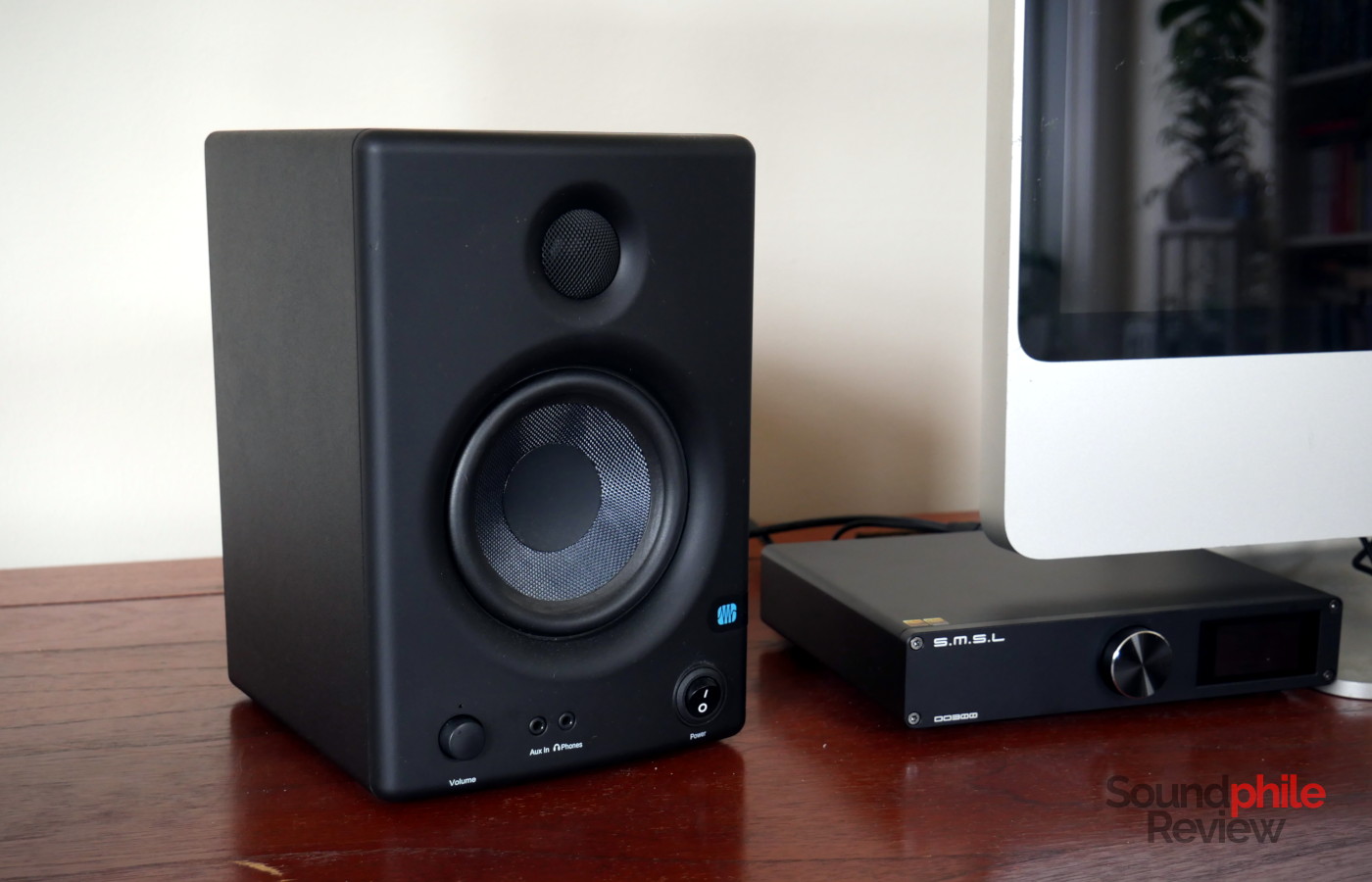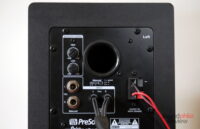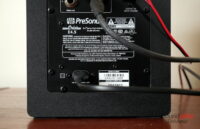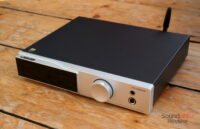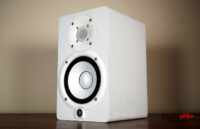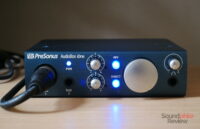The PreSonus Eris 4.5 are powered studio monitors which are targeted at the lower end of the market and at people who look for an upgrade over the audio provided by a laptop. They are relatively small and they fit on most desks, with features that make them quite flexible. PreSonus chose the name “Eris” for their budget line of monitor speakers, and that name identifies the goddess of strife and discord in ancient Greek mythology: a name that seems quite fitting.
Disclaimer: I bought this unit with my own money. Additional information is available on PreSonus’ website. The speakers currently sell for $119.99.
TL;DR: recap
| Pros |
Cons |
| + Small size
+ Affordable + Entertaining as multimedia speakers |
– Not fit for monitoring purposes
– Aggressive, piercing treble spikes – Muddy, overwhelming bass – Strong self-noise (hiss) – No placement settings on newer models |
Rating: 5/10
Packaging & Accessories
The package I got only contains the speakers themselves, a 2 m long speaker cable to connect the two units, and a power lead; the unit I bought was used, so the accessory set wasn’t representative of that provided with new units.
Design & Build
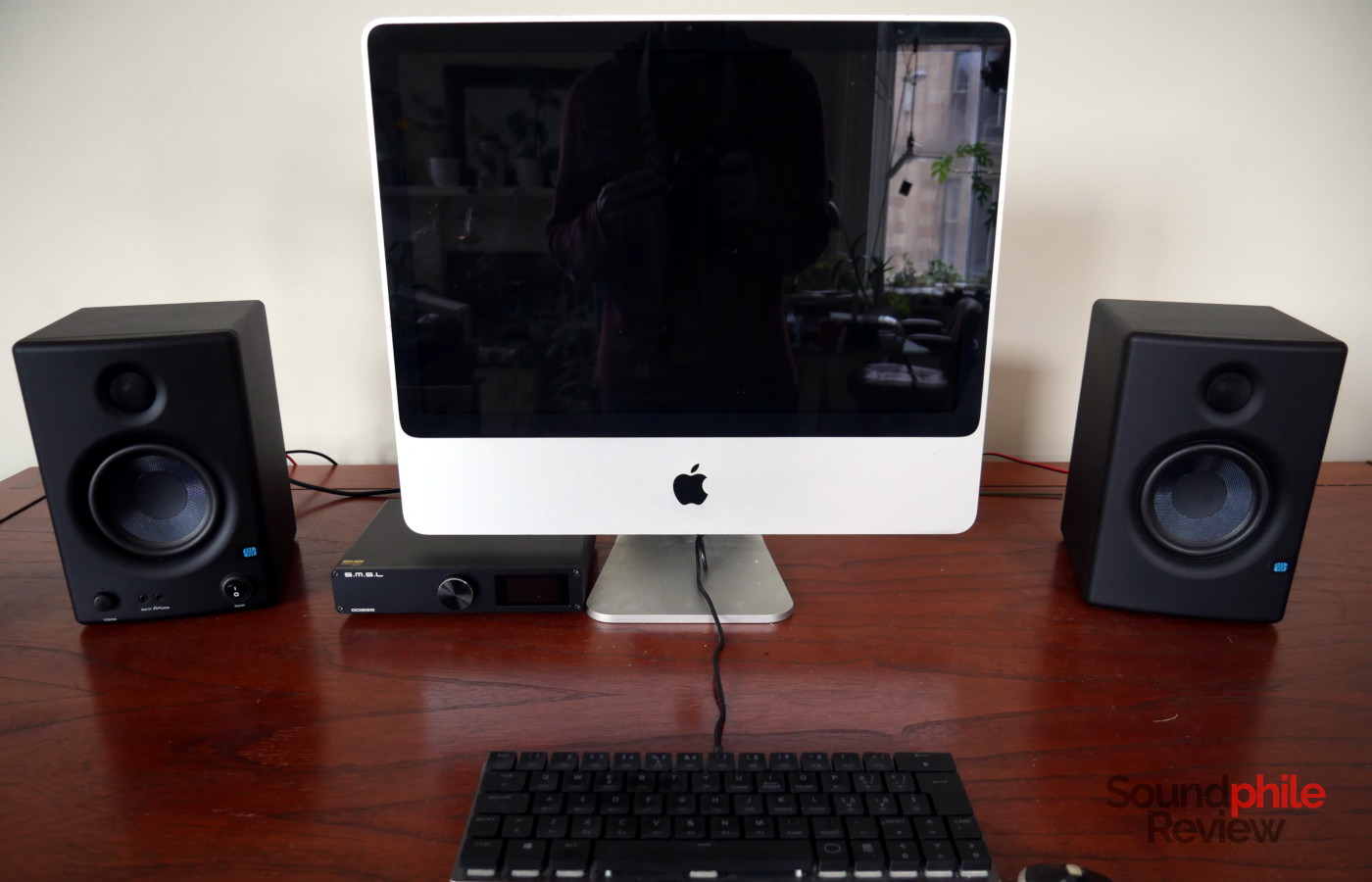
The PreSonus Eris 4.5 sport a black plastic cabinet with rounded edges and a curved front. The design is quite utilitarian and therefore there’s little in the way of aesthetics. The only concession to form is the colour of the woofer’s cone, which is dark blue.
The plastic used for the cabinets is solid enough and its untextured looks (i.e. it’s smooth) make the speakers not stand out, which I actually find a good thing. The size is relatively small, at 24.3 x 15.8 x 17.8 cm, so they should fit on most desks.
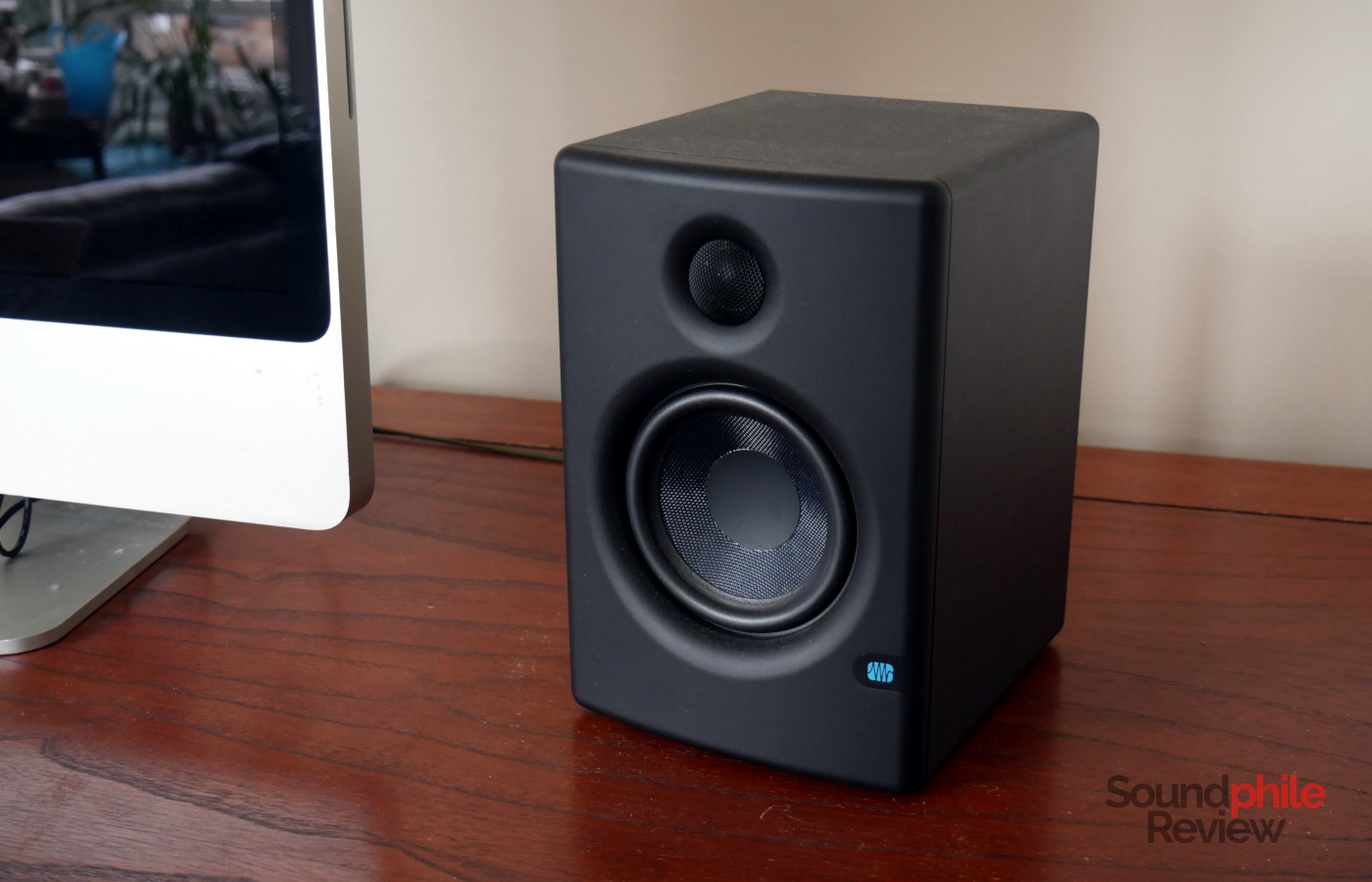
As the name implies, the Eris 4.5 sport a 4.5 inch woofer coupled with a 1 inch silk dome tweeter. The left speaker is the main one where all the controls and inputs are located, while the right one is entirely passive and only has a speaker cable clip. The front of the left speaker has a volume knob, one jack port for aux in and one for headphone output, and the power switch; the back hosts RCA and TRS stereo input, as well as two knobs to adjust bass and treble. Both the left and the right speaker have a rear-firing bass port.
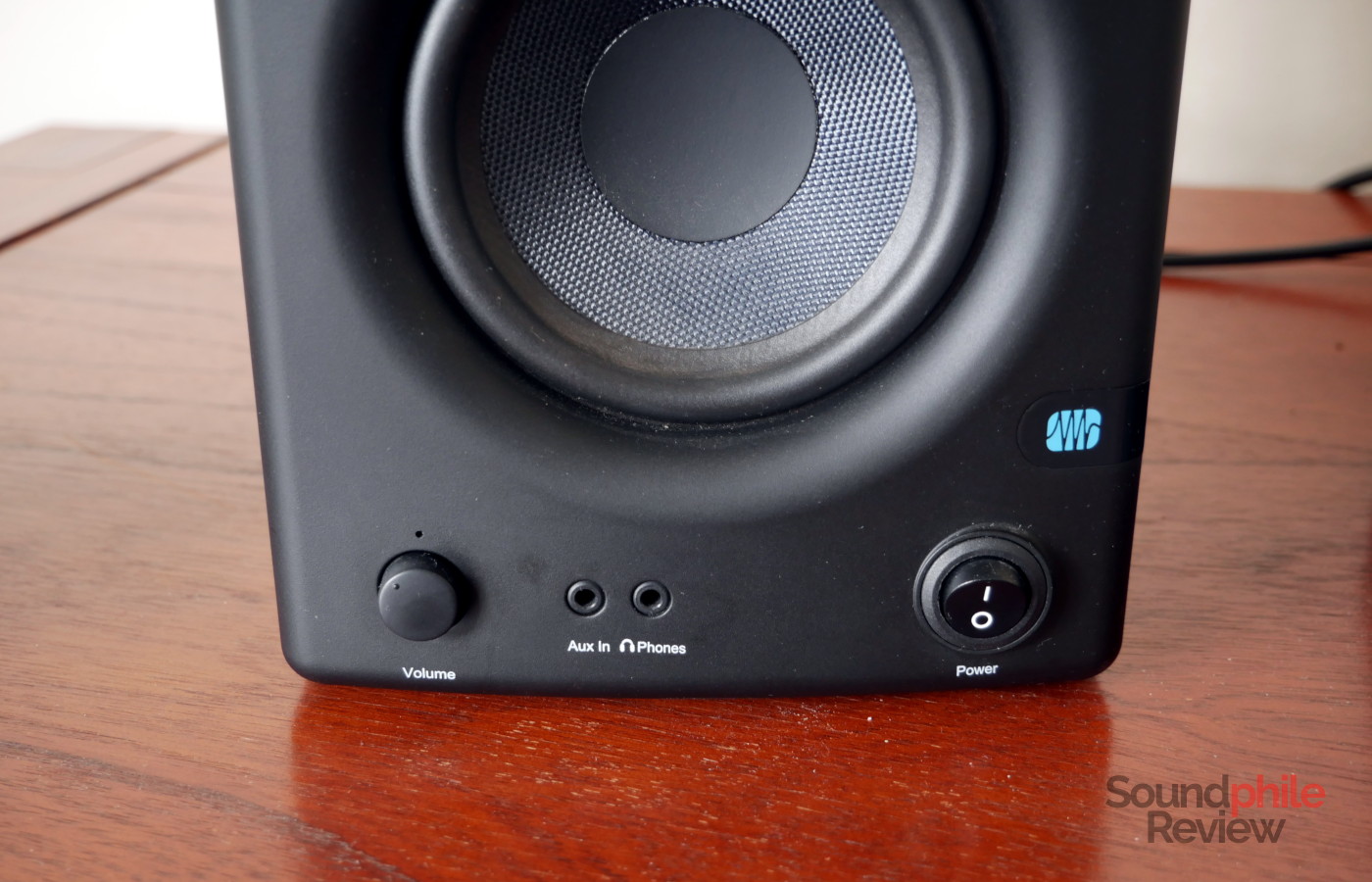
It should be noted that older versions of the Eris 4.5 also featured placement controls that allowed you to change the signature based on how you were placing the speakers, but this feature was removed a few years ago. This limits the choice of placements somewhat, as you will not be able to adjust the tuning as easily.
Considering they sit entirely flat when laid on a surface, it is advisable to actually put them on isolation pads or stands so that they point more directly towards your ears.
Features & Specs
As already mentioned above, the PreSonus Eris 4.5 feature both unbalanced RCA and balanced 6.3 mm jacks as inputs; this gives you good flexibility as it means you can use the speakers with both audio interfaces (which most often feature balanced 6.3 mm outputs, as is the case e.g. with the PreSonus AudioBox iOne) as well as other sources, like DACs or even just computers, smartphones and tablets. The aux input on the front is especially useful if you want to connect a portable device, although these days many smartphones do not feature dedicated audio outputs any more.
PreSonus Eris 4.5 |
| Frequency response | 70 – 20,000 Hz |
| Inputs | RCA, 6.3 mm TRS jack, 3.5 mm jack (front) |
| Power output |
50 W (25 W per speaker) |
With 25 W of power for each speaker, the Eris 4.5 have enough power to get to very high volume, although doing so will push the loudspeakers to their limit and distortion will kick in. At around 80 dB you will still have a very high volume level without too much distortion.
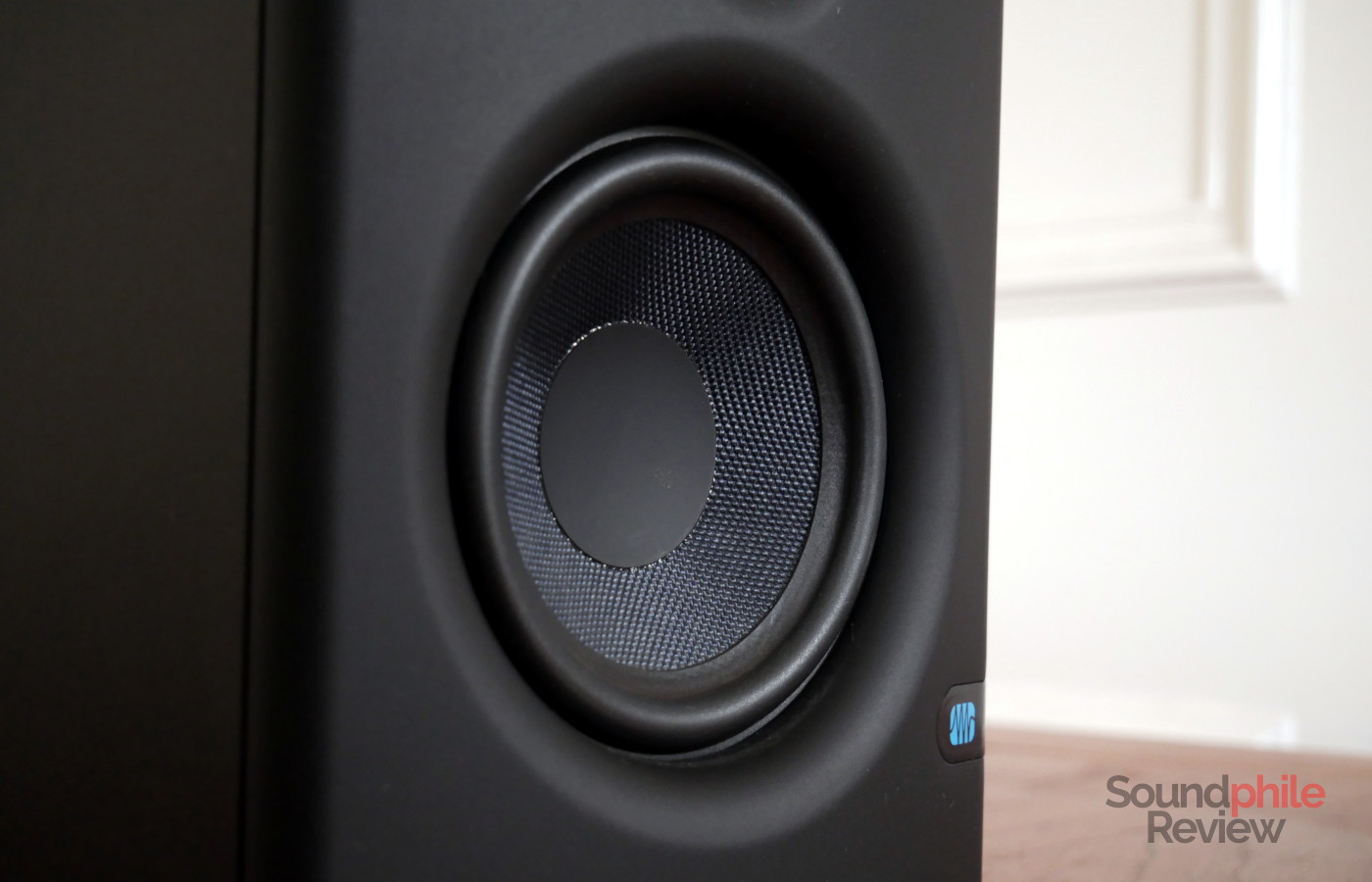
The largest issue with the PreSonus Eris 4.5 is, from my point of view, the loud hiss they exhibit. When I sit at less than 1 metre from the speakers, which is the intended distance for nearfield monitors, the hiss is strong enough to be audible not just when the monitors are idle, but also when they are playing music. As the hiss is in the upper midrange area, it is in the section our hearing is most sensitive to and is therefore intensely fatiguing. The hiss is present even when the Eris 4.5 are not connected to any sources, so it is not a matter of balanced vs unbalanced and is in fact a result of the design of the amplifier.
Sound
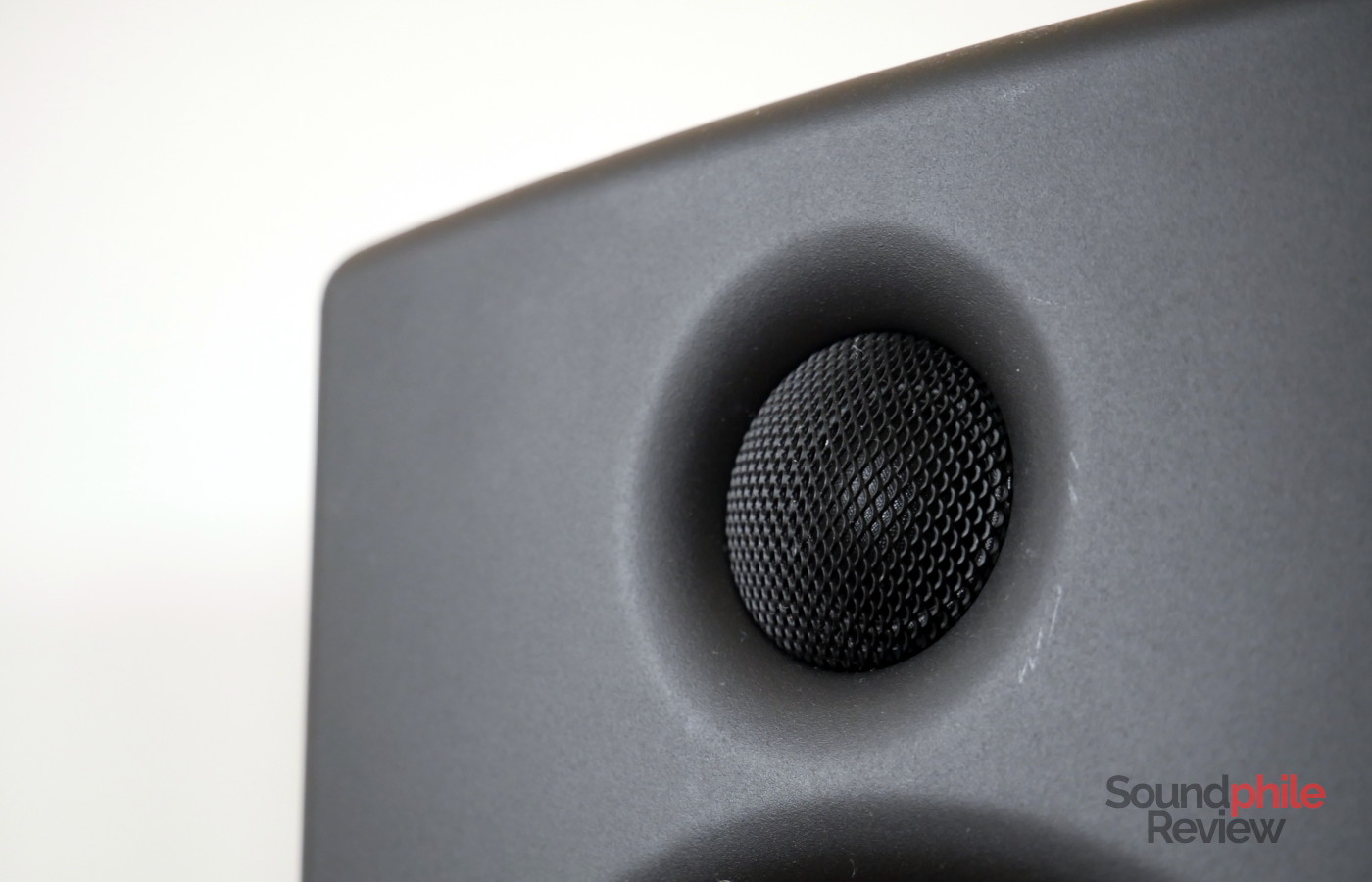
I tested the PreSonus Eris 4.5 using an SMSL DO300 using RCA cables. No detectable difference was there when feeding the speakers through the TRS jacks.
The Eris 4.5 offer limited soundstage width and depth, with the instruments almost always sounding like they’re positioned in the centre of the stage; in a few occasions they sound like their position coincides with the speakers’, but they never sound like they are in a large space. Imaging is therefore quite limited in terms of the space it can work with; the result is that it’s quite poor and it rarely sounds like instruments hold a specific place on the stage which you can accurately point at. Instrument separation suffers greatly from the uneven frequency response and is therefore very limited, especially in the lower part of the spectrum.
Bass is boomy and loose, with a lot more presence in the mid-bass area than in an ideal neutral setting. Sub-bass is non-existing (cut-off on the DSP happens at 70 Hz!), but that’s a given with monitors this small and cheap; the issue is that there’s quite a large bump in the 80-90 Hz area which ends up leaking over the frequencies to its right, suffocating them. It is woolly and lacks control, so you don’t get nice, clean transients with a quick decay, but slow hits followed by a long decay which severely impact the speakers’ ability to convey finer details and good layering.
Midrange is almost V-shaped, due to the influence of bass on one hand, which boosts (and covers) the lower part, and of the emphasised treble on the other. The result is that many instruments sound both emphasised and lacking at the same time; with the middle region being slightly recessed compared to the rest, the result is that many instruments have a weird tonality. This compounds with the lack of instrument separation, which creates a bit of a mash-up where it is difficult to follow individual instruments unless they’re front and centre. We find most of the same issues found in the bass section: as the crossover to the tweeter happens at 2.8 kHz, it’s the woofer that takes care of the mids as well and this leads to a build-up of distortion, which in turn creates the conditions for low speed and loss of details.
Treble is very uneven and has a lot of peaks and dips. While this wouldn’t be an excessive issue per se, the problem is that the peaks are significant and are in the middle area, which makes them sound harsh and piercing. On the other hand, the dips create a situation where some details are lost in the mix and others are emphasised too much. Let’s take Snarky Puppy’s Skate U as an example: there is a constant aggressive ringing in the track due to some of the cymbals, but this only applies to a part of those and many details are lost in the mix, sometimes so much so that the crashes are barely audible. I found out that I am becoming more sensitive to highs and this unevenness displayed by the Eris 4.5 is especially fatiguing to my ears, but apart from this there is another issue: you won’t hear your mixes correctly if you plan to use these speakers for monitoring or mixing. If we step away from quantity and we focus more on quality, the silk dome tweeters do a decent job at representing details, though they certainly won’t blow you away with micro-details and little nuances from instruments; they give you a good idea of what’s going on, but they don’t go further than that.
Final Thoughts
When I bought them, I was looking for a replacement for my IK Multimedia iLoud Micro Monitor which died unexpectedly. I was looking for decently neutral active speakers with no hiss – and found none of these two features in the Eris 4.5. In fact, it is the hiss that immediately convinced me to sell them, as it caused my ears to ring in a very short time; while this is an issue I do have, as my ears appear to be overly sensitive to those frequencies, the hiss is very pronounced and audible even if you are less sensitive to it than me. So while this could be a non-issue to some (and possibly, to many), the Eris 4.5 offer a very uneven frequency response which won’t fit the bill for those who look for a neutral pair of speakers to do mixing and monitoring with. The excessively irregular tuning means you will have to do a lot of correction using EQ, but that will in turn bring a lot of additional distortion – so one way or the other it’s going to be an issue.
The Eris 4.5 could be a good initial choice as multimedia speakers, as an example if you just want to listen to music or game, with no pretence at all regarding neutrality and technicalities. They work decently well as speakers for your computer and they are a definite upgrade over a laptop’s integrated speakers; in fact, if you tone down the highs using the knob on the back you will be able to tame them somewhat and their accentuated bass works fantastically well with games (playing Halo on these speakers is just a pleasure!). But if you are looking for something neutral to do your mixing with, the PreSonus Eris 4.5 won’t be the ideal choice, as their sound signature is just too coloured and would require massive intervention, not to mention the issues with distortion, imaging and instrument separation.

